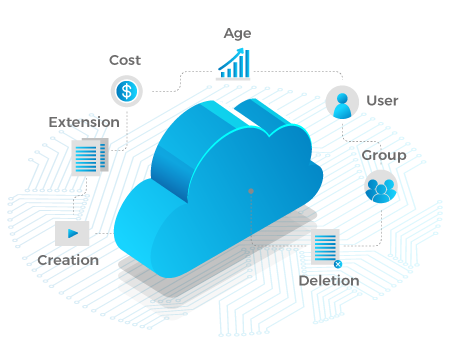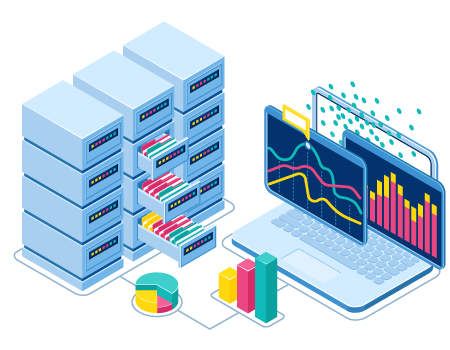
How do you manage Petabytes of unstructured data across multiple locations and cloud?
DNAfabric allows you to index, search, visualize and analyze data across on- premise, remote and cloud.
DNAfabric can index and vizualize storage pools scattered across file-systems, object stores, camera cards and hard drives.
XML, MHL exports can also be ingested. An API allows 3rd party applications to submit for analytics.

On-Premise
NAS, SAN, Tape, Object

Remote
Cards, HDD, RAID

Cloud
Objec, NAS, SAN

Applications
XML, MHL, API

Track and visualize trends across numerous metrics including cost, age, access and more.
Customize views and share with departments, users. Set alerts and trigger actions based on any metrics.
- Multiple Metrics
- Customize Views
- Set Alerts
- Trigger Action
- View Costs for Actions
 Multi-Service Cloud
Multi-Service Cloud Storage Only Clouds
Storage Only Clouds Private Clouds
Private Clouds Media Rich Clouds
Media Rich Clouds Consumer Clouds
Consumer CloudsIndex, Analyze, Visualize and Predict Across Cloud
- Visualize multiple trends and metrics
- Track metrics across object and FS in AWS, Azure, Google Cloud
- Understand costs across storage, access, egress
- Predictive reports to help you select the correct storage tiers

Identify Duplicates
Identify duplicates using a variety of hashes and checksums.
Across On-Premise and Cloud
Check for duplicates across on-premise, remote and across cloud providers.
Reports & Linked Files (*)
Provides reports with linked files for easy duplicate analysis in an application of choice.
*Linked files are supported on filesystems.
Duplicate Removal
Enables easy duplicate removal in an application of choice including Adobe, DaVinci.
FAQ
What types of storage pools can DNAfabric index and analyze?
DNAfabric data managers can be deployed at central, cloud or remote sites. Once deployed, indexers can incrementally walk and index the following types of storage:
- File-system storage (NAS/SAN, Removable drives, Cards etc.)
- Public (e.g. AWS S3, Azure Blob) and Private Object storage (e.g. S3 compatible)
- LTO/LTFS tape storage
- 3rd party file lists e.g. MHL.
Which file-systems and attributes can DNAfabric index and visualize?
- DNAfabric can connect to, index and help visualize numerous file-systems:
- On-premise file-systems (NAS, SAN, camera cards, removable drives).
- Cloud file-systems (NAS, SAN)
- DNAfabric automatically extracts and indexes file size, names, extension, mod times, access times (*if supported), user, group rights (**) and more.
**Support coming in upcoming release
Which public/private object stores and attributes can DNAfabric index and visualize?
- DNAfabric can connect to, index and help visualize numerous object stores including:
- Public object storage: AWS S3, Azure Blob, Google Cloud, Backblaze B2, Wasabi.
- Private object storage: Any S3 compatible storage e.g. Minio.
- DNAfabric automatically extracts and indexes file size, names, extension, mod times, access times (*if supported), user, group rights (**) and more.
**Support coming in an upcoming release
Which consumer cloud stores (e.g. Dropbox, Frame.IO) and attributes can DNAfabric index and visualize?
- DNAfabric can connect to, index and help visualize numerous consumer object stores including:
- Consumer cloud storage: Google Drive, Dropbox, Box, OneDrive, Frame.IO (**).
**Support coming in an upcoming release
Which tape storage and format can DNAfabric index and visualize?
DNAfabric can index existing LTO tapes in LTFS format (* DNAevolution product needed)
What 3rd party file lists can DNAfabric index and visualize?
DNAfabric can ingest MHL formats (**) with customizations available for other XML formats.
**Support coming in an upcoming release
Does DNAfabric extract camera metadata attributes?
DNAfabric can optionally extract metadata from over 300+ camera and file formats. This can be extended to custom or newer file formats as well.
Which metrics can DNAfabric visualize?
DNAfabric tracks and helps visualize numerous metrics across cost, ageing, access, creation, deletion, file-type distribution, duplication and more.
How does DNAfabric duplication analysis work?
DNAfabric can detect duplicate file and object entries based on hashes. Each file in its index is compared against every other file and a report is generated that allows easy identification and remediation of duplicates.
DNAfabric can detect duplicates in which storage platforms – file-systems, object, tape?
Duplicate data can be found across any storage types that DNAfabric can index. This includes file-systems, object storage, tape storage and 3rd party hash lists e.g. MHL.













